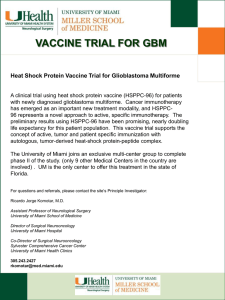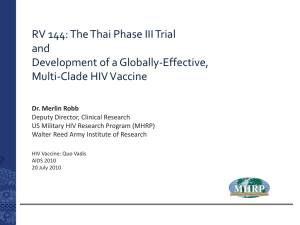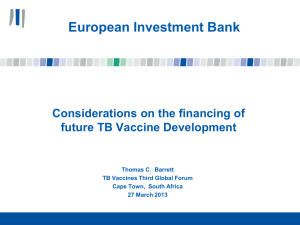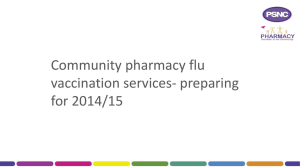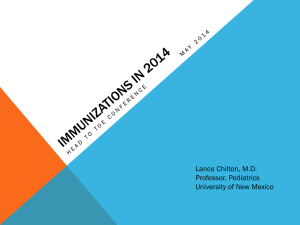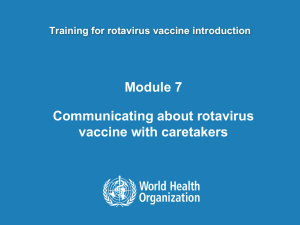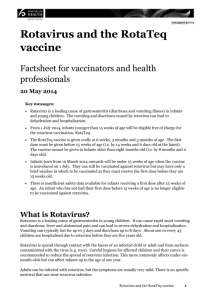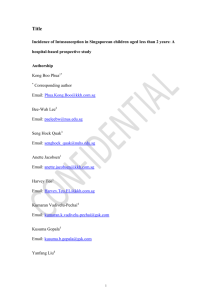2. Gagandeep Kangro
advertisement
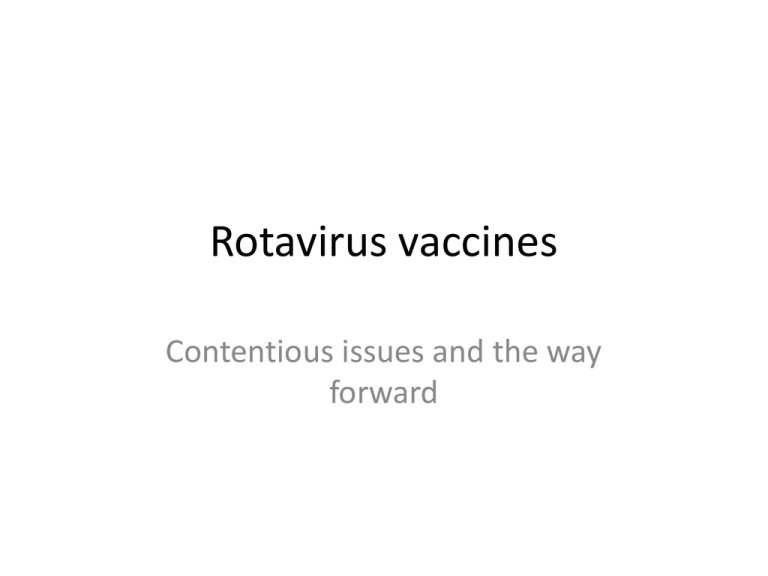
Rotavirus vaccines Contentious issues and the way forward Conflict of interest • Work on rotavirus infection and vaccination in my group is supported by the WHO, European Commission, ICMR, DBT, PATH and the Bill and Melinda Gates Foundation • We serve as the clinical laboratory for Phase II studies by Shantha Biotech and Serum Institute of India • We are conducting a phase III study for Bharat Biotech India Ltd (Financial support from DBT and PATH) • We will test samples from the phase III study for Serum Institute of India (Financial support from PATH) Key questions • Will the current vaccines work as well in India as elsewhere? • Which vaccine is better? • What is the risk of intussusception? • Will strain replacement take place? • Is there a need for the vaccine in the universal immunization program? • Is the age restriction necessary? Will the current vaccines work as well in India as elsewhere? What’s driving the rapid roll out of rotavirus vaccines? Figure 1. Number of Diarrhea-Related Deaths among Children 59 Months of Age or Younger from July 2002 through May 2009 in Mexico, According to Age Group. Vaccine coverage and rotavirus disease in 6 countries Impact on hospitalizations and costs • In the USA, nationally, for the 2007-2009 period, there was an estimated reduction of 64,855 hospitalizations, saving approximately $278 million in treatment costs Cortes et al, NEJM, 2011 Africa • Rotarix – 4417 infants in per-protocol efficacy analysis – Pooled vaccine efficacy, 61.2%; 95% CI, 44.0 to 73.2%. – Vaccine efficacy lower in Malawi than in South Africa (49.4% vs. 76.9%); – Number of episodes of severe rotavirus gastroenteritis that were prevented was greater in Malawi than in South Africa (6.7 vs. 4.2 cases prevented per 100 infants vaccinated per year). Madhi et al, NEJM, 2010 Africa • Rotateq – 5468 infants – Pooled vaccine efficacy, 39.3%; 95% CI, 19.1 to 754.7%. – Vaccine efficacy lower in Mali than in Ghana or Kenya – Vaccine efficacy lower in second season than first – IgA seroresponses 73-82% Armah et al, Lancet, 2010 Asia • Rotateq – 2036 infants – Vaccine efficacy 48.3% (95% CI 22.3–66.1) against severe disease Zaman et al, Lancet, 2010 So what should we expect in India? • No vaccine efficacy data as yet • Immunogenicity data from a phase II study with 116E vaccine showed 89% IgA seroresponse • Efficacy studies for 116E have completed enrollment and are ongoing Bhandari et al, J Infect Dis, 2009 Key data on protective immunity from Mexico studying natural infections 33 (22 - 42) 2 Subsequent infections are less severe 3 Second infections 1 Complete protection from moderate to severe gastroenteritis after 2 infections were more likely to be caused by another G type (P0.054) Velazquez et al, NEJM 1996 Protection against rotavirus diarrhoea Outcome and no. of previous infections No. of episodes Incidence per 100 child months 371 13.81 1 338 8.5 2 236 6.7 3 100 4.68 0 84 3.13 1 70 1.76 2 32 0.91 3 15 0.70 Unadjusted relative risk (95% CI) Adjusted efficacy (95% CI) Any infection 0 0.62 (0.53 – 0.71) 0.49 (0.41 – 0.57) 0.34 (0.27 – 0.42) 39 (29 – 47) 52 (43 – 59) 67 (59 – 74) Mild diarrhoea 0.56 (0.41 – 0.77) 0.29 (0.19 – 0.44) 0.23 (0.13 – 0.39) 44 (23 – 59) 72 (58 – 81) 79 (64 – 88) Moderate to severe diarrhoea 0 17 0.63 1 21 0.53 2 10 0.28 3 3 0.14 0.83 (0.44 – 1.58) 0.45 (0.21 – 0.98) 0.22 (0.07 – 0.76) 18 (-57 – 57) 57 (6 - 80) 79 (29 -94) Comparison of severity between orders of rotaviral infection Comparison of Mexican & Vellore cohorts Mexico Vellore No. of children recruited & completing follow up 200 (77% follow up) 452 (373 with 99.5% follow up) Frequency of visits and stool 1/week, 1/week + diarrhoea 2/week, 1 in 2 weeks + diarrhoea Infections identified 316, 57% stool and 77% serology 1103, 48% stool and 76% serology Order of infection 52% first infections, 48% subsequent 30% first infections, 70% subsequent Time to infection 34% infected by 6 mo 53% infected by 6 mo Symptoms in 1st infection 47% 30% Severity No child had moderate to severe diarrhoea after 2 infections 22.4% of 3rd or later rotavirus diarrhoea were moderate or severe Velazquez et al, NEJM, 1996 Gladstone et al, NEJM, 2011 Modeling the impact of vaccination given current data 1 Vaccine impact (1-relative incidence) 0.9 >>High income incidence >>Middle income incidence >>Mid/high income natural protection 0.8 0.7 0.6 >>High income immunogenicity >>Middle income immunogenicity 0.5 >>90% coverage 0.4 Baseline (Low income, 70% coverge) 0.3 0.2 0.1 0 Lopman et al, PloSOne 2012 0 1 2 3 4 Years since start of vaccination program Which vaccine is better? Licensed oral rotavirus vaccines • Rotarix ® (GSK) live, oral, monovalent, human P[8]G1, attenuated by serial passage in cell culture • Two dose schedule along with EPI/routine childhood vaccinations • 85% efficacy against severe rotavirus disease and hospitalizations (two dose schedule, 6 and 10 weeks) Ruiz-Palacios et al, NEJM, 2006 Licensed oral rotavirus vaccines • Rotateq ™ (Merck) live, oral, human-bovine reassortant (P[8], G1, G2, G3, G4) • Three dose schedule with EPI/routine childhood vaccinations • 74% and 98% efficacy against all and severe rotavirus disease Vesikari et al, NEJM, 2006 Comparison of Rotarix and Rotateq Angel et al, Nat Rev Microbiol, 2007 Type specific protection in developing countries Study Vaccine G1 protective efficacy P Value Non-G1 protective efficacy P Value Ref Africa Rotarix 64.1 (29.9–82.0) 0.002 59.7 (37.1–74.4) <0.001 Africa Rotateq 32.3 (–1.8 - 55.4) 27.1—87.5 Asia Rotateq 46.2 (–13.5-75.7) 29.1-67.2 Madhi et al, NEJM 2010 Armah et al, Lancet 2010 Zaman et al, Lancet 2010 Serum neutralizing antibodies with Rotateq in Asia Serum neutrailizing antibody to G1 G2 G3 G4 P8 Vaccinee Placebo Vaccinee GMT Placebo GMT 32.1 9.9 2.3 0.8 99.5 23.0 19.9 12.5 28.2 18.3 27.5 3.0 0 5.3 30.8 51.4 78.9 10.1 15.1 18.0 Serum IgA responses were seen in 87.8% of vaccinees and 18.2% of controls Zaman et al, Lancet, 2010 What is the risk of intussusception? Intussusception and the first licensed vaccine • Tetravalent human-rhesus reassortant rotavirus vaccine (RRV-TV) developed at NIH • Manufactured by Wyeth, licensed in 1998 as Rotashield® • 1.5 million doses given • Vaccine Adverse Events Reporting System identified possible association with intussusception • Withdrawn by the company in 1999 Intussusception in vaccine trials • Rotashield was calculated to have a risk of one excess intussusception per 10,000 vaccinees • The Rotateq and Rotarix trials had nearly 70,000 children each in the safety studies • No increased risk found, but companies asked to report intussusception for the first 3 years after licensure by the Federal Drug Administration in the US Post-marketing surveillance • Mexico 2008-2010, attributable risk of 3 to 4 additional cases of intussusception per 100,000 vaccinated infants (Velazquez et al, Ped Infect Dis J, 2012) • US 2000-2009, Compared with 2000-2005, the rate was greater in 2007 (rate ratio [RR], 1.10), similar in 2008 (RR, 0.95), and lower in 2009 (RR, 0.93) (Yen et al, J Infect Dis, 2012) • US 2006-2010, no increased risk (Shui et al, JAMA, 2012) • US 1997-2009, no increased risk (Zickafoose et al, Arch Pediatr Adolesc Med, 2012) • US 2006-2008, no increased risk (Loughlin et al, Ped Infect Dis J, 2012) • Mexico and Brazil, short-term risk of intussusception in approximately 1 of every 51,000 to 68,000 vaccinated infants (Patel et al, NEJM, 2011) • Australia, no overall increase in intussusception following receipt of rotavirus vaccine, there was some evidence of an elevated risk following the first dose of both vaccines (Buttery et al, Vaccine 2011) • US, 2006-2008, no increased risk (Belongia et al, Ped Infect Dis J 2010) Will strain replacement take place? Strain replacement • Two reports of disappearance of G1 strains and replacement with G2P4 strains in Brazil after introduction of nationwide introduction of rotavirus vaccine • Gurgel et al, Emerg Infect Dis 2007, Nakagomi et al, Arch Virol 2008 Strain reassortment • Vaccine or vaccine-reassortant rotavirus strains detected in 5 (4.7%) of 106 immunocompetent children who required treatment for rotavirus gastroenteritis at a large pediatric hospital in Texas in 2009-2010. • Four strains were related to pentavalent rotavirus vaccine while one was related to monovalent rotavirus vaccine. Boom et al, J Infect Dis 2012 • Is there a need for the vaccine in the universal immunization program? • Is the age restriction necessary? Country level vaccine efficacy against severe rotavirus diarrhea incidence and 2009 under five mortality Fischer Walker and Black, BMC Public Health, 2011 Public health implications Fischer Walker and Black, BMC Public Health, 2011 Public health impact • Rotavirus vaccine prevented severe rotavirus episodes in all regions; 81% of episodes in Latin America, 42.7% of episodes in high-mortality Asia, 50% of episodes in subSaharan Africa, 88% of episodes low-mortality Asia and North Africa, and 91% of episodes in developed countries • Although vaccine efficacy is lower, impact on severe disease and mortality is high because of the high incidence • Higher vaccine efficacy is desirable but should not delay use of an effective public health tool Thank you
